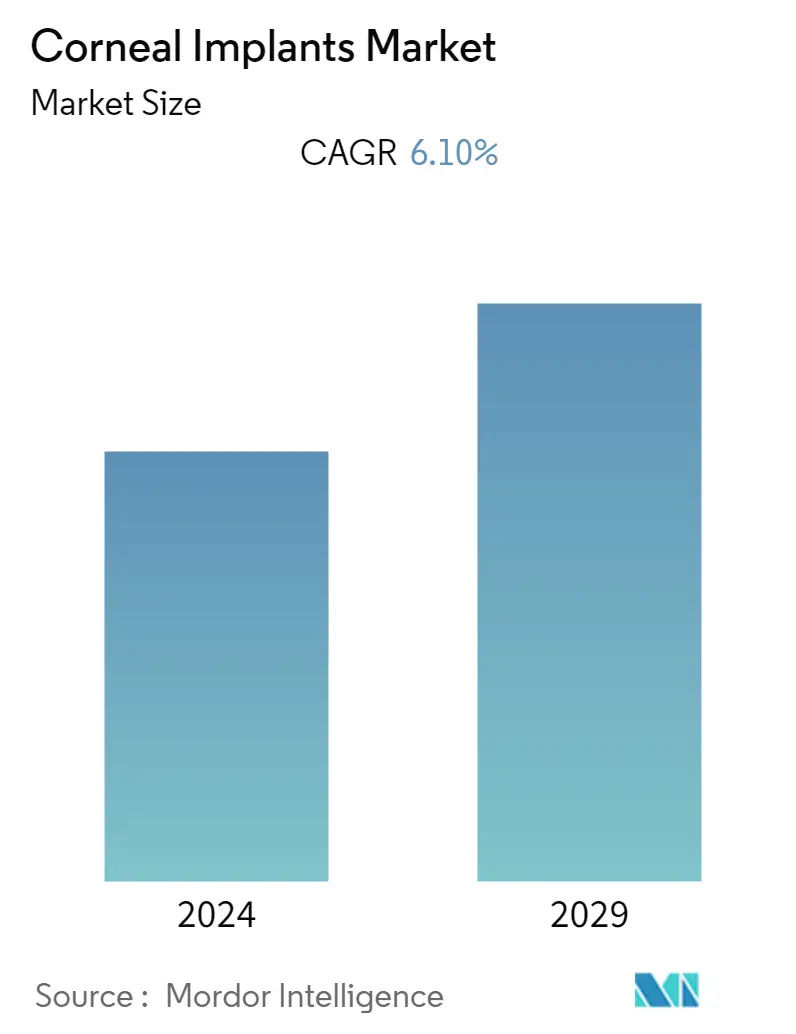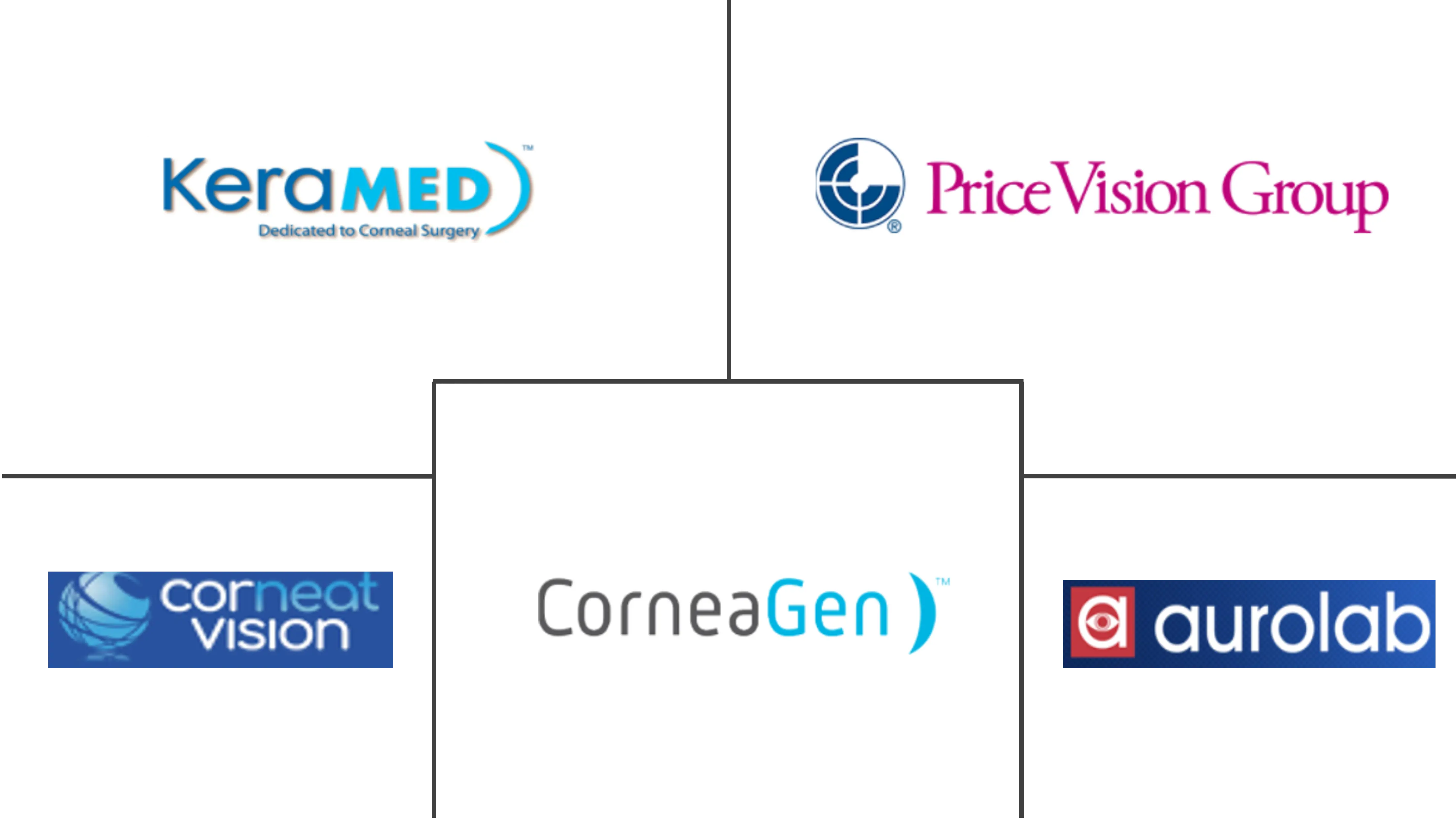Market Size of Corneal Implants Industry

| Study Period | 2019 - 2029 |
| Base Year For Estimation | 2023 |
| CAGR | 6.10 % |
| Fastest Growing Market | Asia-Pacific |
| Largest Market | North America |
| Market Concentration | Medium |
Major Players
*Disclaimer: Major Players sorted in no particular order |
Need a report that reflects how COVID-19 has impacted this market and its growth?
Corneal Implants Market Analysis
The corneal implants market is projected to register a CAGR of 6.1% during the forecast period.
The rapid emergence of the COVID-19 pandemic has had a significant impact on ophthalmic surgery across the globe. The suspension of elective procedures during the pandemic reduced the number of patients undergoing ophthalmic surgery globally, as ophthalmic procedures are considered elective procedures. Also, in March 2020, CMS recommended the cancellation of elective surgery as part of the national response to COVID-19. Moreover, in March 2020, the AAO released practice guidelines advising ophthalmologists to cease providing any treatment other than urgent and emergent care. Moreover, as per August 2021 published by the International Journal of Environmental Research and Public Health, no rebound effect was observed once the pandemic restrictions were eased. Simultaneous bilateral cataract surgeries (SBCS) constituted 6.5% of cataract procedures performed in April 2021 and May 2021 compared with 0.77% carried out between May 2019 and March 2021. Hence, the COVID-19 pandemic impacted the market at the initial stages of the pandemic but then started to cover significantly as the COVID-19 cases started to subside.
The market growth can be largely attributed to the factors such as technological advancements in corneal implants, the increasing prevalence of the geriatric population, and growing incidences of eye disorders worldwide. These factors are leading to a huge demand for corneal implants in healthcare facilities. The geriatric population is prone to suffer from Fuchs' dystrophy which is treated with endothelial keratoplasty (EK). According to a March 2020 article published in Progress in Retinal and Eye Research, the late-onset form of Fuchs' endothelial dystrophy is a common condition, affecting approximately 4% of people above 40 years of age in the United States. In addition, bullous keratopathy is the most common condition among older people who undergo cataract surgery. Such patients are recommended to undergo an EK procedure. Moreover, as per the World Population Ageing 2022 report by the UN, the share of the global population aged 65 years or above is projected to rise from 10% in 2022 to 16% in 2050. By 2050, the number of persons aged 65 years or over worldwide is projected to be more than twice the number of children under age 5 and about the same as the number of children under age 12. Thus, the increase in the geriatric population will fuel overall market growth.
Moreover, the demand for collagen-based artificial corneas is increasing owing to their biocompatibility and low cost which has led to the development of bio-engineered artificial corneas. In addition, increased R&D activities in this area are contributing to market growth. For instance, in July 2020, CorNeat Vision developed an easily implantable and affordable artificial cornea, CorNeat KPro. The CorNeat KPro has been designed to replace scarred, deformed, or opacified corneas and is anticipated to fully and immediately rehabilitate the vision of corneally blind patients. The product is expected to achieve CE marking and US FDA clearance in 2022. Also, in June 2021, Israeli ophthalmology startup, EyeOn Medical, received a CE Mark for its flagship product EndoArt, the world's first synthetic corneal implant designed to counteract corneal edema. Thus, the aforementioned technological developments are contributing to the rising demand for corneal implants.
Also, due to the growing incidence of eye disorders worldwide, there is a huge demand for corneal implants. Corneal implants are used in the treatment of keratoconus, corneal opacity, corneal blindness, and other eye disorders. As per the 2020 statistics by the Cornea Research Foundation of America, 50 to 200 out of every 100,000 people in the general population were affected by keratoconus disorder in 2020. This indicates that an increase in several people suffering from keratoconus disorder is expected to increase the demand for corneal implants. In addition, as per the 2020 statistics by the RNIB, an estimated number of 4.1 million people in the United Kingdom will be affected by blindness by 2050. Furthermore, as per the WHO statistics of 2021, globally, approximately 2.2 billion people had near or distant vision impairment and 4.2 million people had corneal opacities in 2020. Such a huge number indicates a high demand for corneal implants. Thus, all the above-mentioned factors are currently augmenting the growth of the corneal implant market.
However, the high costs of surgical procedures and ophthalmic devices and the availability of alternative treatments are some of the factors impeding the market growth.
